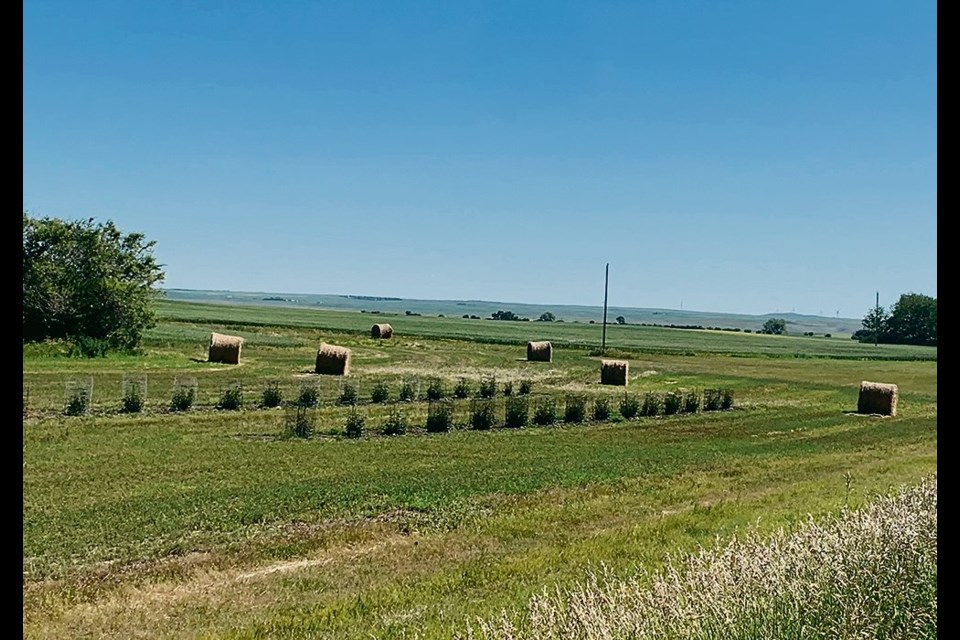WESTERN PRODUCER — In May of 2020, I planted a COVID-19 Victory Garden. Many others were doing the same in their backyards. I chose to plant mine in the field across the road from the farmhouse.
The field included a six-acre piece that had never yielded much, perhaps because of a wide strip of Manchurian elms, which formed a nice windbreak but were now starting to spread their wings and were robbing some of the moisture from the crop.
We sowed the six acres down to a mixture of alfalfa and grass and rototilled two strips about eight feet wide at the lower end of the piece to take advantage of any runoff.
We planted 15 saskatoon seedlings in each strip, leaving enough room to rototill between each tree. They had already made it through one winter in the nursery and were 12-18 inches high. We fertilized each plant and distributed mulch around the stem and left a well so the water would pool.
We are very aware of the wildlife in our area: deer, rabbits, gophers, the occasional moose, and lots of birds. We decided on a four-foot-high rabbit fence that had a smaller grid at the bottom and gradually gave way to larger openings. This formed a cylindrical fence around each tree.
In southwestern Saskatchewan, the criteria for erecting anything outside is will it stand up to the wind? We were determined, so we pounded in three or four pieces of rebar, each about five feet in length and interlaced each bar through the fence. The neighbours were either intrigued or prescient concerning the results.
By 2021, we would realize the rabbits couldn’t nip at the base of these tender seedlings, but the deer could sneak their narrow noses in through the openings and eat any new leaves. By the end of the summer, we had wrapped each rabbit fence in plastic mesh to keep the deer from pruning our trees. We also decided to put a small canopy of mesh over the top of each cylinder. Once again, hindsight proved we should have entirely encased the top.
This summer, we were happy to see that the trees were flourishing under our care: regular watering, occasional fertilizing and rototilling and weeding. The alfalfa would grow up near the base of the trees so it had to be regularly snipped. By the way, the alfafa-grass mix yielded five big round bales last year and nine this year around the two rows of trees.
We were feeling confident we would be eating saskatoon pie in August. I crossed the road to my “orchard” frequently; everything looked bountiful, another week and the saskatoons would be ready to pick.
We decided to take a short four-day break from watching our other crops grow and visit friends in Manitoba. A crop tour through southeastern Saskatchewan and southern Manitoba is always a treat. We were not disappointed. After such a wet spring in those areas, we were happy to see that crops were in good condition. We returned to our farm on a Sunday, and early the next morning, I took a medium-sized bowl out to pick my saskatoons. I could already taste the pie.
The first tree had yielded more than a cupful, a good harvest I thought for just over three years of growth.
As I neared the next tree and the next, my heart sank. In every case, the birds had flown in under the small piece of mesh, which had not completely covered access to the tree. There was no way they could have gotten in through the mesh on the sides, but we had left openings in the tops by using a square piece of mesh and tying each corner to the rabbit fence. There was plenty of room for the birds to get in — we could see they had picked every berry from its neat little stem.
In the end, I was able to extract only the one cup of berries from my 30 trees. I’ll be sure to wrap the tops thoroughly this fall. Next year, each tree will be fortressed against the wind, the deer, and the birds.
My one cup of berries is a small victory for us, but well worth the scrumptious cobbler I plan to make for supper.




